What Hi-Fi? Verdict
Set aside the comparison with the Q90R and see the Q90T for what it is: an excellent, aggressively priced 4K TV that does things its OLED rivals simply can’t
Pros
- +
Brilliantly bright and punchy
- +
Superb operating system
- +
Improved motion and sound
Cons
- -
Slightly exaggerated colors
- -
OLEDs offer better blacks
Why you can trust What Hi-Fi?
The Samsung Q90T is a slightly tricky proposition. It’s the top 4K TV in Samsung’s 2020 TV range, but as a result of the company’s increased focus on 8K, it’s also less of a flagship model than last year’s equivalent.
Any whiff of a downgrade is bound to set alarm bells ringing, but it’s rarely sensible to draw conclusions from a spec sheet alone. And so it proves here: the Q90T is an excellent TV and a great alternative to its OLED rivals.
Pricing
The Samsung QN55Q90T price is currently $1700. It launched at $1800, so has already had a bit of a discount. This new, lower price, is exactly the same as LG is currently charging for the OLED55CX. We don't imagine that's a coincidence.
Buyers in some countries can spend a little more to get a Q95T, which is the same as the Q90T but adds a more stylish remote and the One Connect system, but this model is not currently available in the US.
If you’re after a bigger TV, the Q90T is also available in 65in, 75in and 85in sizes.
Features
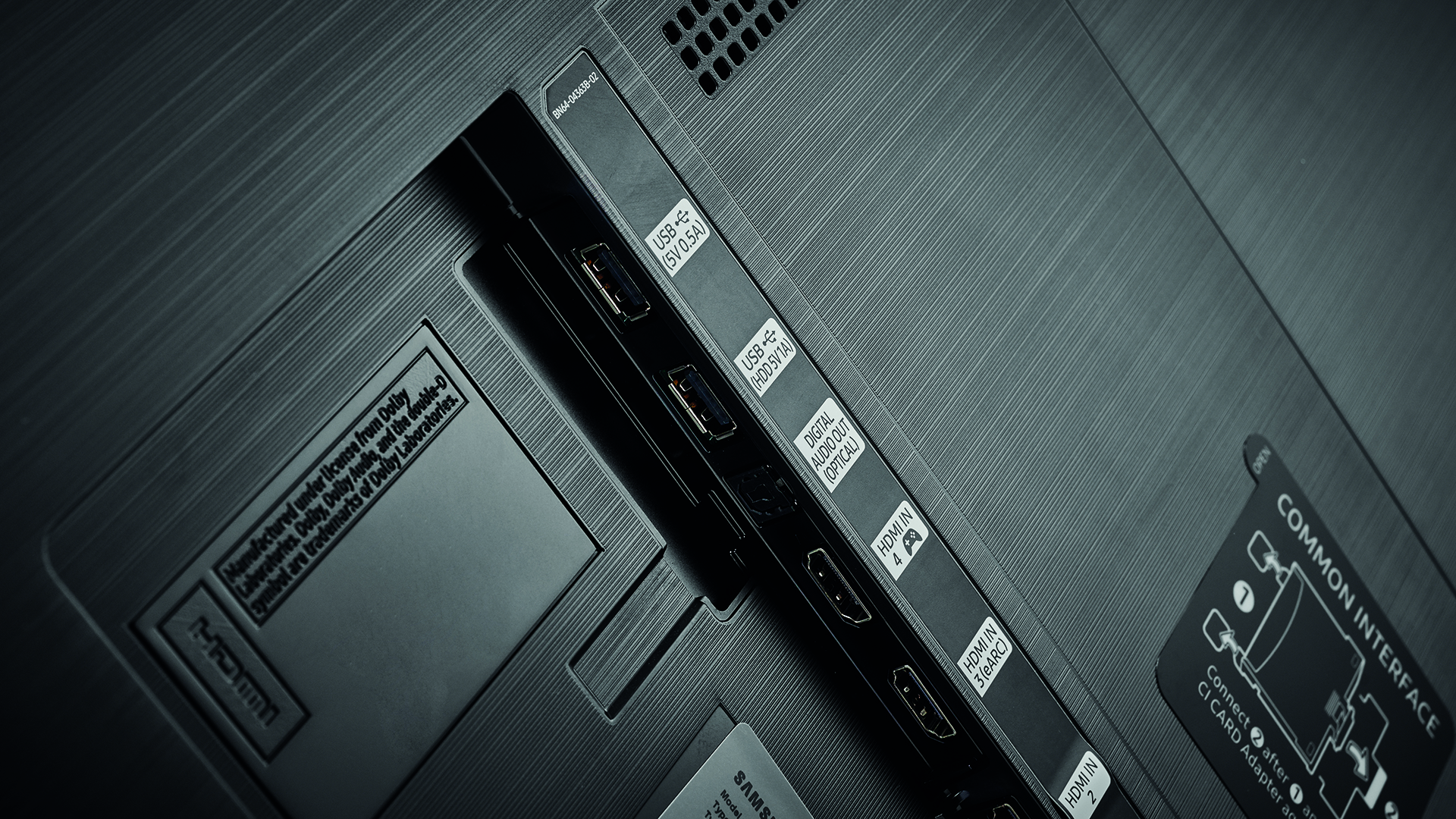
What’s surprising is that in some ways the Q90T has lower specs than last year’s Q90R. That’s because Samsung sees the Q90R’s true replacement as being the Q800T, which is an 8K model. No, that doesn’t make sense to us either.
Boil it all down, though, and Samsung’s top 4K model in 2019 was the Q90R, and its top model for 2020 is the Q90T, so the comparison is more than valid, and it does throw up some on-paper disappointments, the biggest of which concerns the backlight.
This is, of course, a QLED model with a direct, full-array backlight. But while the Q90T has the same 2000nits peak brightness rating as last year’s Q90R, it has far fewer dimming zones. Samsung doesn’t release specific numbers, but our understanding is that the Q90T has only around a quarter of the number of zones of the Q90R.
In most ways, though, the Q90T is equal to, or an upgrade on, the Q90R. It gets an anti-reflective screen, for example, as well as the effective wide viewing angle tech that Samsung introduced last year.
There’s a new version of the Quantum Processor 4K, too, and this brings with it new features such as Ultimate Precision Processing, which is designed to reduce banding in lower resolution content, and upgrades to existing features such as Texture Creation (for increased perceived detail) and Active Tone Mapping (for highlights that better combine punch and authenticity).
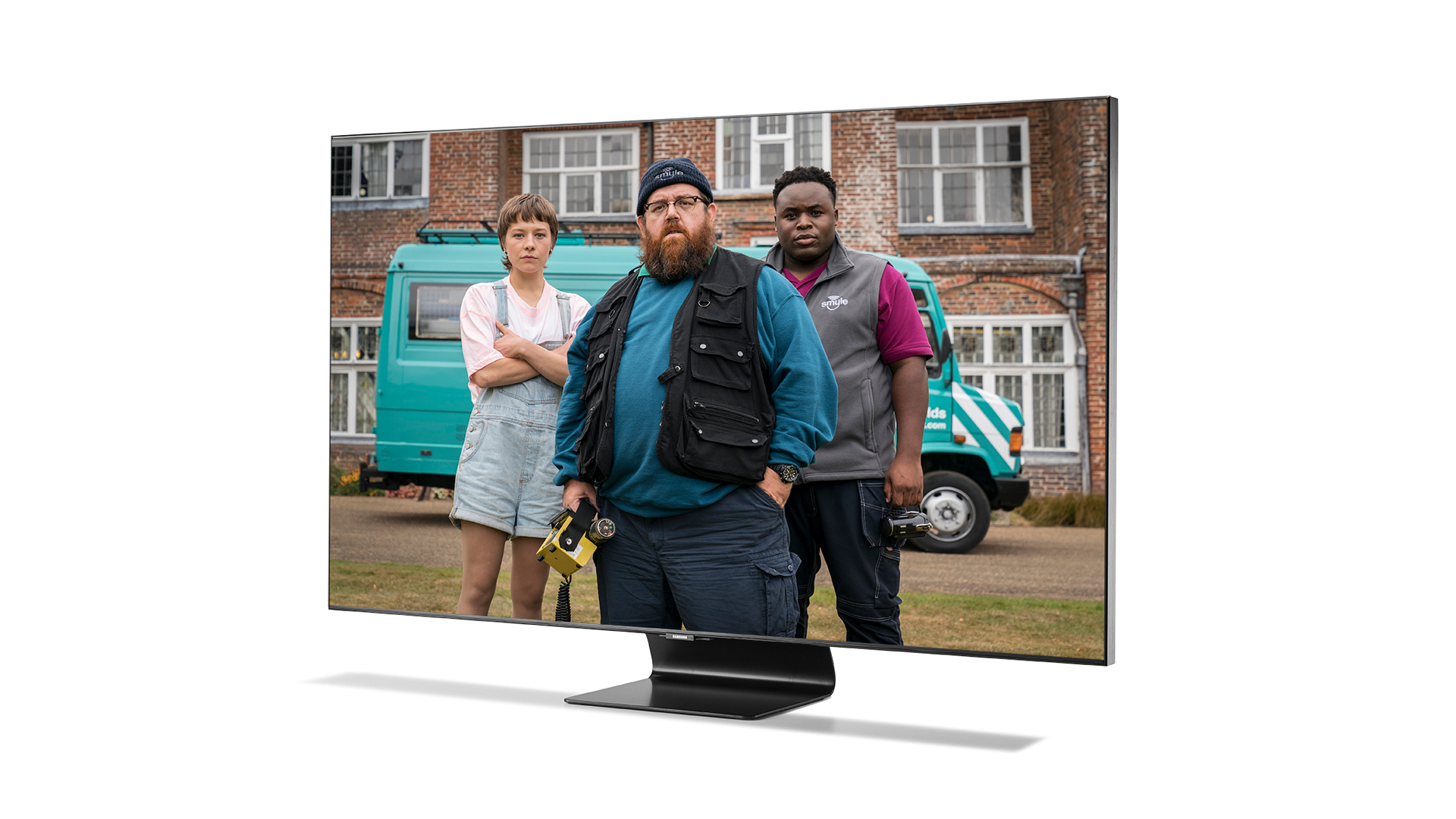
Screen type QLED
Resolution 4K
Operating system Samsung Tizen
HDR formats HDR10, HDR10+, HLG
HDMI x4
USB x3
Optical x1
The sound system has had an upgrade, too. Both the Q90T and Q95T have an eight-driver system arranged in what Samsung calls a 4.2.2 configuration. Those numbers shouldn’t be interpreted as with a Dolby Atmos system, though. Instead we’re dealing with four mid-range drivers, two woofers and two tweeters. Two of the mids are positioned along with the two woofers at the bottom of the chassis and the other two mids and the tweeters are at the top.
Samsung refers to the technology as ‘Object Tracking Sound’ and says this produces a bigger, more open and more even sound. While that might make it sound quite Atmos-like, it’s important to note that the TV doesn’t actually reproduce Atmos soundtracks – although it will pass them from an external source or integrated app to a dedicated sound system using HDMI eARC (Enhanced Audio Return Channel).
Samsung’s 4K TVs continue to lack official HDMI 2.1 certification, but they do support every HDMI 2.1 feature of note, from eARC to HFR (High Frame Rate), ALLM (Auto Low Latency Mode) and VRR (Variable Refresh Rate). These features will be of particular interest to gamers, especially those eyeing up the PS5 or Xbox Series X, and the Q90T’s gaming credentials are further enhanced by an input lag of just 11ms and a couple of gaming-specific picture features that can smooth motion and increase dark detail.
As mentioned, the Q90T lacks the Q95T’s One Connect box, so all connections are located on the rear of the set, just as they are on all non-Samsung TVs. As well as the four HDMI sockets, you get three USBs, an optical audio output, and both aerial and satellite sockets. There’s no physical headphone connection – Samsung expects you to use Bluetooth.
The black plastic remote that’s included might not be as stylish as the silver version that came with the Q90R, but it’s arguably more ergonomic and is just as pleasant to use. In fact, with its three dedicated streaming shortcut buttons (for Netflix, Amazon Prime Video and Samsung TV Plus), it’s actually the more useful zapper. The integrated microphone can be used to access Alexa or Samsung’s Bixby voice assistant. The latter is better in this context, as it allows for direct control of the TV itself. You can even turn the set on using your voice, as long as the remote is nearby.
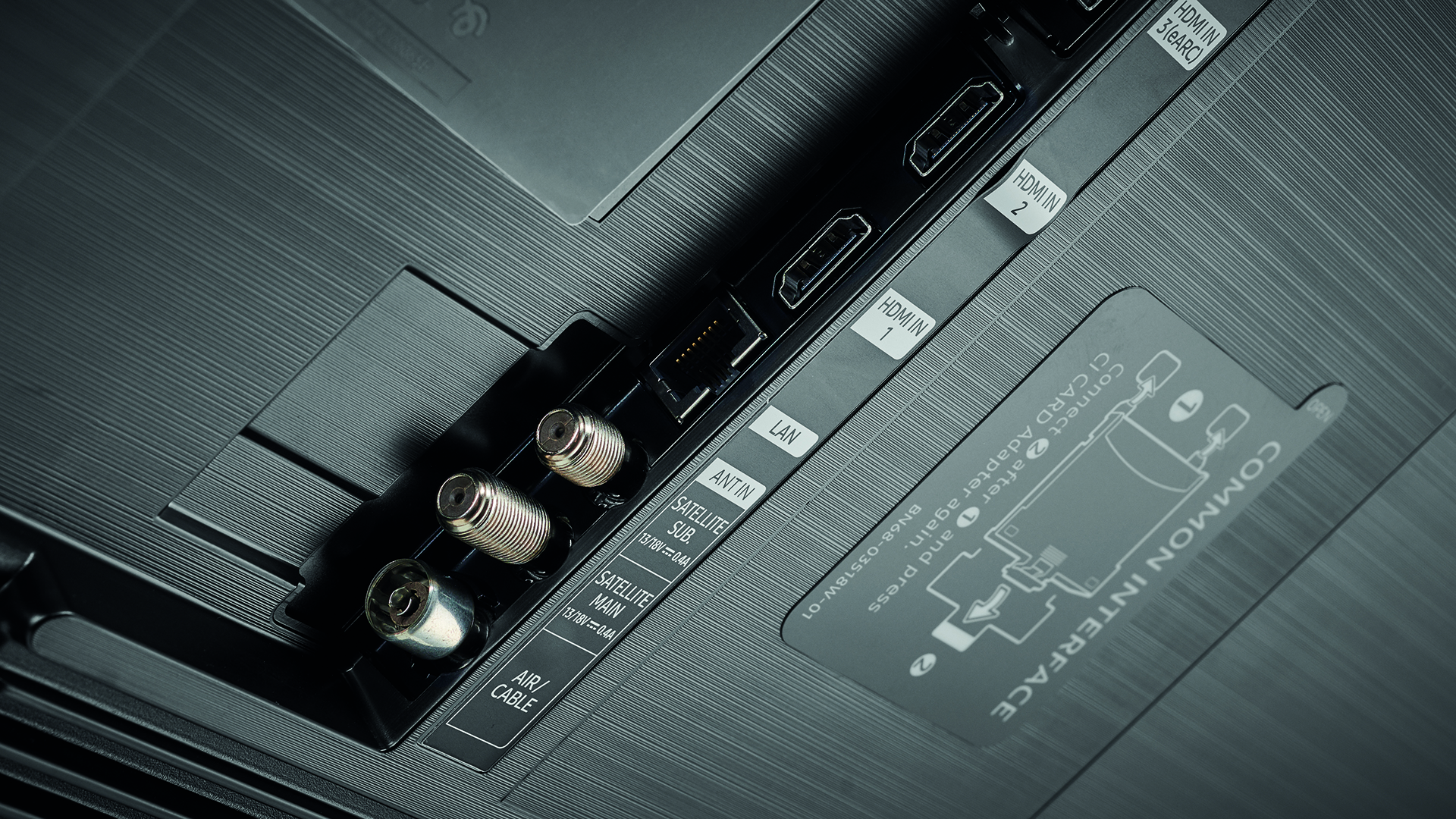
The Tizen operating system is as good as ever. Not only is it fluid and intuitive, getting you quickly to the content you want, it offers the most comprehensive selection of apps. You get Netflix, Amazon Prime Video, Disney+, Apple TV and Google Play Movies & TV, all in 4K and HDR, plus HBO Now, Hulu, Vudu and ESPN. Spotify, Tidal, Apple Music and Amazon Music are also on board.
There's simply no significant gap in Samsung’s offering, and that's a massive plus point. AirPlay 2 is built in, too, giving Apple users yet another way to get audio and video content onto the TV’s screen.
The biggest disappointment in terms of specs is the continued lack of Dolby Vision. Samsung appears determined to stick with its rival HDR10+ format, despite Dolby Vision being far more prevalent and generally better implemented.
Considering the Q90T lacks the Q95T’s One Connect box, it’s interesting that the two sets are dimensionally identical. The Q90T is no chunkier than its more expensive sibling, and that means that while it lacks the super-thin section of panel that all OLEDs have, instead being 1.4 inches thick almost from edge to edge, all of its OLED rivals are actually thicker at their thickest points. The LG CX, for example, is just 6mm thick in some places, but 1.9 inches elsewhere.
Wall-mounters who go for a flush wall mount will find that the Q90T’s thick, straight edges make it look rather like a chunky picture frame - in a good way. It can even mimic an art installation via the built-in Ambient Mode.
If you’re placing the TV on a piece of furniture, you’ll likely appreciate that the iMac-like pedestal stand is just 13.5 inches wide. It also has a low profile and creates a good gap between the tabletop and screen – perfect for adding a soundbar.
Picture
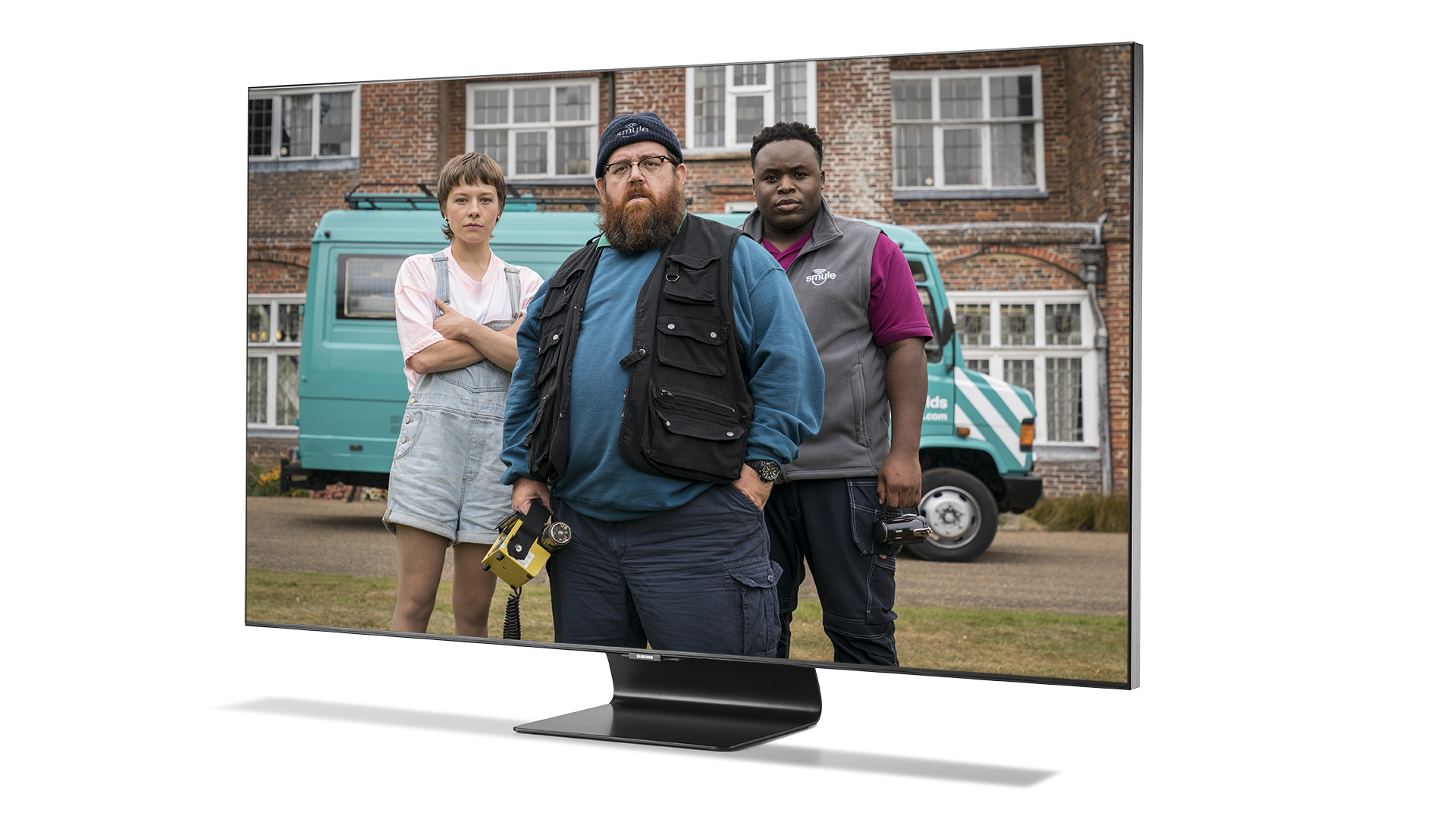
Kicking off with Blade Runner 2049 on 4K Blu-ray, there is a lot to like about the Samsung’s delivery. The improvements over the Q80T in terms of contrast and colors are obvious. This is a much punchier and more vibrant performer.
It’s vastly brighter than its OLED rivals, too. In most scenes, the image pops from the screen in a way that OLEDs simply can’t match. The exception is when the set is asked to produce a small bright object on an otherwise dark image, such as the scene-setting text at the start of the film.
Here, the Q90T is more reserved than the Q90R, presumably because the reduced number of dimming zones means that going too bright would risk the possibility of bloom from the backlight. In fairness, a number of similarly priced OLEDs also hold back here, but the LG CX produces brighter highlights in these testing, high contrast scenarios.
It’s also true that while the Q90T has exceptional black depth and viewing angles for a backlit TV, in these regards it’s still not quite a match for an OLED. When bright picture elements appear to the top or bottom of the viewing area, the corresponding black bar loses its ultimate depth. It’s barely noticeable in normal viewing, but put this Samsung next to an OLED and you’ll see what real black is. Of course, if the Q90T had as many dimming zones as the Q90R, this slight flaw likely wouldn’t be there – or would at least be minimized yet further.
But while the Samsung loses a couple of battles to all OLEDs, it also does some things that no OLED can do. That punch and vibrancy makes the presentation endlessly exciting and engaging. Play the scene in which K meets Ana Stelline for the first time and the forest memory she’s creating is lush and verdant to a degree that only a QLED can manage.
And when she switches off the hologram, the white lab in which she works is stark, crisp and bright, just as it should be. When the lights are dimmed so that Ana can work on the birthday cake memory, the Q90T proves that, while its blacks aren’t as flawlessly deep as those offered by its OLED rivals, they are brilliantly detailed.
For sharpness and detail, the Q90T is also among the best in class. It produces a more solid, deep and three-dimensional image than almost any rival. But, on occasion, the Samsung’s colors also look a little exaggerated. It certainly skews a little more red than is truly neutral and, while that makes for a pleasant balance most of the time, skin tones can occasionally look just a touch off. Ana Stelline’s face, when lit up by the birthday cake, is a perfect example.
Samsung has taken a big step forward in terms of motion processing this year, though. The default settings still result in a rather over-processed image, but switch to the Custom setting and you get a decent amount of smoothing and sharpening without anything looking artificial. Samsung still isn’t at the same level of Sony or Panasonic in this regard, but it isn’t far off.
Drop to the 1080p, non-HDR Blu-ray of The Duchess and the Samsung continues to impress. Once again, sharpness and detail are excellent, and the delivery is lovely and punchy, too. There’s still a slightly exaggerated rosiness here, but it’s less pronounced.
Go all the way down to standard-def, as we do with Spaced on Netflix, and the Samsung is a little less smooth and controlled in its delivery than the very best in class, but is also more vibrant and fun.
Sound
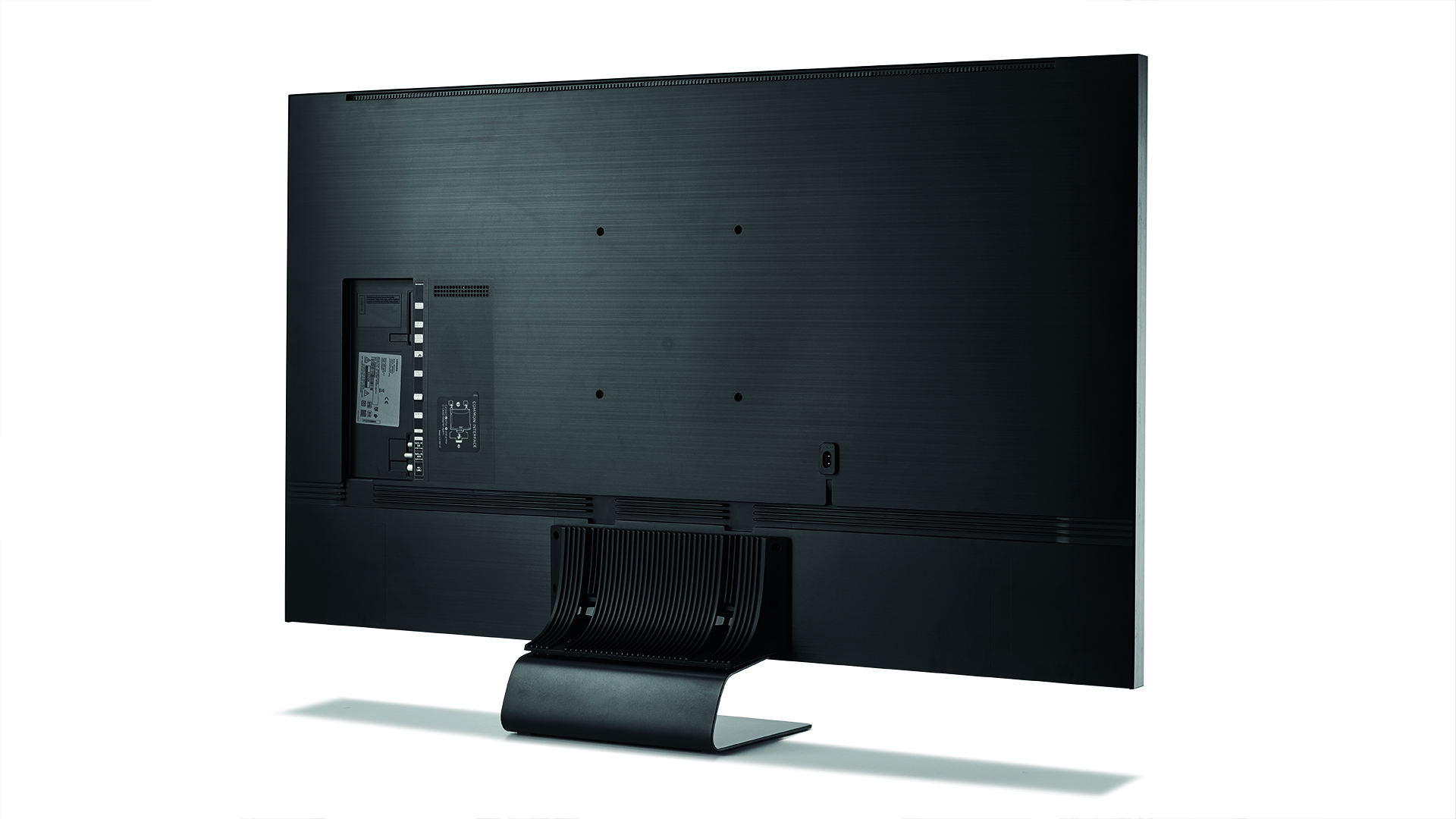
Samsung has also taken a big step forward this year in terms of sound. The eight-driver system of the Q90T makes it significantly crisper and clearer than its predecessors and the more affordable Q80T. It’s also weightier and deeper in terms of bass, but without the usual forced, inauthentic boom that’s common of TVs attempting to compensate for having small speakers.
This is a tonally natural and balanced sound, and there’s decent dynamic subtlety and a good combination of spaciousness and directness. Play one of the scenes in Blade Runner 2049 in which K takes his baseline tests, and you get a good sense of the echo in the hard, windowless room along with strong clarity and a reasonable amount of nuance.
The opening of chapter two of the film is a challenge too far for the Q90T’s speakers, though, at least when Adaptive Sound+ is switched on. Here the deep, thumping bass causes a bit of rattle and flap from the TV’s woofers. The LG CX suffers similarly, but their rivals largely do not.
You can overcome it with the Q90T by disabling Adaptive Sound+, but the overall delivery is then smaller, less dynamic and less weighty. Because the issue is rare (this is the only scene that caused it during all of our testing), Adaptive Sound+ is probably still worth using, but if you do encounter problems, turning it off will likely fix them.
Of course, you can solve this issue entirely and get a big overall upgrade in terms of sound by partnering the Q90T with a separate sound system. The Sonos Beam and Sonos Arc are the current soundbars of choice and will work well here, or you can go for a full home cinema system if you have the space and budget.
Verdict
Whether you consider the Q90T to be the successor to the Q90R or not, it is a better TV overall. It has a more natural balance, significantly better motion and a much-improved sound system. It’s true that it doesn’t go quite as bright in those high contrast scenarios and doesn’t go quite as black but, in fairness to Samsung, the Q90T is more aggressively priced: this time last year, a Q90R would have set you back more than the Q90T costs right now.
More important than how it fares against its discontinued sibling, though, is how it fares against similarly priced 2020 TVs from rival manufacturers. Essentially, we’re talking about OLEDs such as the LG OLED55CX.
These sets go blacker and, in the case of the LG, produce brighter highlights in otherwise dark images, but the Samsung is vastly punchier with almost everything you watch and images pop from the screen in a way that OLEDs still can’t match. It also has the best, most app-packed operating system and a feature set that will keep it relevant for years to come.
There’s no doubt that the Samsung Q90T is an excellent TV, and you certainly shouldn’t discount it for not being an OLED or not having as many dimming zones as its ‘predecessor’.
SCORES
- Picture 5
- Sound 4
- Features 5
MORE:
Read our LG OLED55CX review
Read our Philips 55OLED805 review
What Hi-Fi?, founded in 1976, is the world's leading independent guide to buying and owning hi-fi and home entertainment products. Our comprehensive tests help you buy the very best for your money, with our advice sections giving you step-by-step information on how to get even more from your music and movies. Everything is tested by our dedicated team of in-house reviewers in our custom-built test rooms in London, Reading and Bath. Our coveted five-star rating and Awards are recognised all over the world as the ultimate seal of approval, so you can buy with absolute confidence.
-
taylor3397 Unfortunately, the occasional exaggerated colors, especially the reddish skin tones, is a deal-breaker for me. Since it wasn't mentioned in the review, can I assume this feature can't be balanced in Settings?Reply -
Sav The lack of dolby vision on Samsung TVs is unfortunate, especially for people like me who watch mainly Netflix, as much of their new content is now DV. But in the real world, how much do the Samsungs struggle to convey properly DV content?Reply

